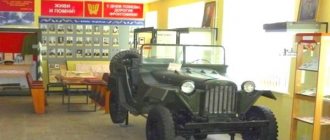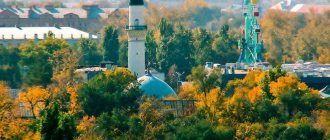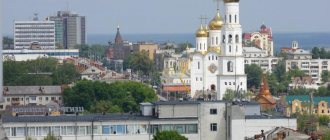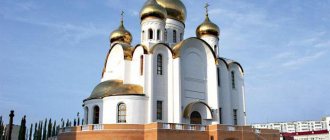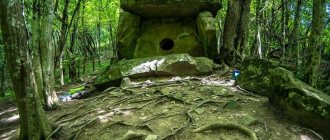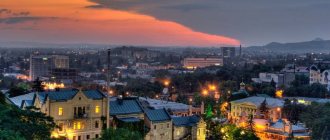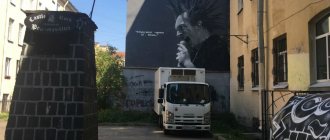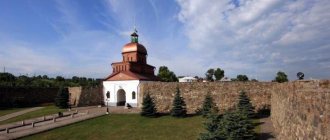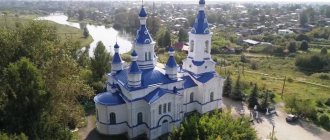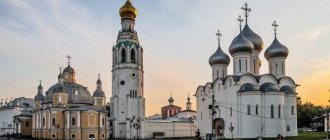- September 13, 2018
- Attractions
- Liya Arturunyan
The Belgorod region itself is very beautiful, it is endowed with a huge number of natural attractions; Belgorod has at its disposal many springs, swamps, reservoirs, ponds and sources of mineral waters. They are all located in different places, but many of them are definitely worth a visit.
One of the most visited places in Belgorod is the Belogorye nature reserve; its area exceeds 2000 hectares. The reserve was founded in 1999 and consists of 5 different areas, each of which has its own unique feature. The list of the most visited places, namely the attractions of the Belgorod region and Belgorod, is presented below. After all, judging by the reviews of tourists, they are all worthy of visiting. And the main thing is that you can enjoy most of them for free, which people especially like.
Other interesting places
While in Belgorod, be sure to go to the windmill in order to see this interesting structure with your own eyes.
In Belgorod you can find many interesting fountains, for example, Patron or Nika.
Steam locomotive museum. This interesting place in the Belgorod region was founded in 1943. The museum has more than 1,000 different exhibits that were witnesses and direct participants in the Railway Revolution. Exhibits that took part in the Stakhanov movement, those that became participants in the Great Patriotic War. The museum exhibits can be viewed from absolutely all sides and even touched.
You should definitely linger a little at the central fountain in Belgorod. It has a rectangular shape with balls and rectangular bridges. It is recommended to visit this place in the evening, as there is amazing lighting there.
Friendship Alley. This is a very interesting place to go for a walk. The highlight of this park is a large forged tree, which with its intertwined roots symbolizes the close connection between the sister cities. At the central tree, the alley paths diverge on both sides.
Unusual floating fountain. This is the largest fountain in the city of Belgorod, the stream of this structure rises to a height of 25 m. When night falls, the fountain is illuminated by lamps, giving the water an unusual color. In addition to being colorful, the fountain is also musical. It is considered one of the largest floating fountains in Russia.
You should definitely visit the landmark of the Belgorod region - a natural monument, the long-lived oak. Not far from Belgorod, in the village of Dubovoe, there is an oak tree that is over 300 years old. The height of this tree is over 30 m. These are truly amazing places. You can walk through the forest and enjoy the pristine nature. As for this place, there is a belief that it was planted in honor of the reunification of Ukraine and Russia.
Belgorod Zoo is considered one of the largest zoos throughout Russia. The total area of this reserve is 3.3 hectares. The zoo is home to more than 40 species of birds, 41 species of mammals, 6 species of reptiles, as well as various animals and insects.
An unusual monument of nature and architecture is the vinegar tree. This attraction is the only one in the park on Pravoberezhnaya Street. Few people have seen a living vinegar tree, so when you are in Belgorod, you should definitely go and have a look at it.
Climate of the Belgorod region
Winter period
The climatic character of the Belgorod region is moderate continental. In winter there are snowfalls and thaws, with the first snow in October or November. But the winter temperature does not set right away; the weather is changeable for about two weeks: the snow either falls in a thick layer, or immediately melts. Permanent snow covers the ground only in December and lasts a little more than three months. The maximum height of snow cover in open areas is 21 centimeters; for the southern regions of the region it is slightly lower. But there are periods when the snow disappears completely in the middle of winter due to a thaw.
The coldest time of the year is January. The average minimum temperature is -8.5°C. There are also very cold winters, when temperatures can reach -37°C.
Summer period
Summer in the region is quite long and hot, with little precipitation. The average summer temperature is +15°C. About 25 days per season precipitation falls in the form of rain, for this reason the territory of the Belgorod region is considered dry. The maximum temperature in summer can reach +39°C.
The first frosts can occur as early as August, when there is a sharp drop in summer temperatures. Autumn is quite fleeting, just like spring. Its first half falls on a period of warming, the so-called “Indian summer”. Since October there has been a cooling and nature is preparing for winter.
Air Traffic Control Museum
In 2010, an unusual museum was opened. Then the Belgorod region detachment celebrated the 17th anniversary of its founding. The museum houses many interesting specimens that are related to the investigation of high-profile crimes. Visitors are given the opportunity to explore the features that are associated with the work of the ATC squad, because the museum has many interesting exhibits. Upon entering this establishment, one can enjoy the vehicles that were previously used by the employees of this department.
Flora of the Belgorod region
The Belgorod region is covered with forests by almost 10%, so its territory is forest-steppe. More than 800 hectares of forests are characterized as a specially protected area. Many groups of unique plants and animals of the region are listed in the Red Book.
“Yamskaya steppe” is a very valuable segment of mixed-grass meadow steppe, which is part of the Alekhine nature reserve, located in the Starooskolsky district. The “Yamskaya steppe” has been protected since the time of Peter 1.
The forests of the region are mainly broad-leaved species. Also, it is rare to find oak forests in their pure form. The forest area of the region is multi-tiered and is represented by the following species: rowan, bird cherry, maple, linden, wild apple and pear trees, ash.
In places of cut down or burnt forests, peat bogs, and on the bottoms of ravines, small-leaved forests form.
Small islands of sandy and chalk forests represent the eastern and southern regions of the Belgorod region.
In the territory of lowland swamps there are cattails, marsh marigolds, reeds and cattails. Sphagnum, wild rosemary, cuckoo flax and cranberries can be seen in areas of high humidity in the west of the region. The wild flora is rich in medicinal plants, among them: sage, field geranium, St. John's wort, chamomile, wild rose hips, and thorns.
Monuments of Belgorod
If you are thinking about what to see in the Belgorod region, you should pay attention to the monuments. List of the most popular:
- Monument to Vladimir the Great.
- Monument to Tsar Fyodor Ivanovich.
- Monument to Bohdan Khmelnytsky.
- Sculpture “Heart of the City”.
- Monument dedicated to the widow and mother of a soldier.
- Memorial Battle of Kursk. A monument in honor of the legendary battles, it was installed on the battlefields.
- An unusual monument called “Dream”.
- Monument to the incorruptible traffic cop.
- Sculpture "Memories".
- Monument-tablet.
- Sculpture of a movie camera.
- Sculpture "Local history".
- Monument to the egg.
- Sculpture "Girl and Dog".
Belgorod has a huge number of different attractions that are definitely worth seeing when visiting the city. This place pleases tourists and will give them many unforgettable experiences, as evidenced by numerous reviews. Belgorod and the Belgorod region are an example of how history should be honored. The number of memorial and architectural structures associated with the Great Patriotic War is amazing.
Belgorod is also famous for its ponds, forests and squares, which people also speak of with delight. The temples and cathedrals in this city are majestic. Belgorod is the place where the icon of the Mother of God was found. The city has many interesting shopping and entertainment centers where you can go for a walk with your children.
Barkov's Mill
This is a very unusual wooden mill building. It is six stories high, which is rare for wood construction. Moreover, all six floors are made of larch logs, perfectly calibrated in diameter, and all this was done without a single nail, instead, wood veneer was used. The foundation of the building is made of lime, but there is no consensus; some researchers believe that it is made of egg white.
It is unknown how this mill worked before the revolution. Most likely - with the help of a water wheel, and downstream there was a chalk-brush dam. Legend has it that the mill was originally located in a different location. But then the merchant Barkov won it at cards, and the building was transported to the village of Novoivanovka, where it still stands today, on the banks of the Oskol River.
It is believed that this happened in 1914. But the mill operated for many years after that. Of course, the production itself has undergone modernization. After World War II, the mill was equipped with a diesel engine and electric motors, which also operated for many years. The machines that have been preserved in the building have signs stating that they were manufactured in the 1950s at the Voronezh Mechanical Plant.
A major overhaul of the mill was carried out in 1990. After that, it worked until 2004, when production was stopped and the mill itself was recognized as an architectural and historical monument, which is protected by the state. You can get inside the building as part of a guided tour. In addition, since rural tourism is developed in this area, and kayaking is organized on the Oskol River, the mill has become part of this popular tourist route.
(
3 ratings, average: 2.67 out of 5)
Mammals of the Belgorod region
Even in the recent past, the Belgorod region could boast of such inhabitants as lynx, bear and other large forest animals. But as a result of the extermination and improvement of lands for farming, a change in fauna occurred. In the post-revolutionary period, the natural world of the region came under special protection. Hunting for useful animals was limited and categorically prohibited for particularly rare ones.
Among mammals, ungulates have become widespread. Moose are especially proud. Previously, in the 50s, these animals had just begun to develop the territory of the Belgorod region, and therefore were under special protection, which contributed to their reproduction. Now moose are not such a rarity in these places.
All small oak forests are inhabited by wild boars. In especially large forests (the southern part), there were many wild goats, which were practically exterminated during the war years. Now they are protected in the reserve.
Soil of the Belgorod region
The formation of soil is greatly influenced by steppe and forest vegetation. Thanks to these zones, black soil and gray forest soils arose. The region is dominated by black soil.
Chernozem is the most fertile soil (occupies 77% of the region's area), which creates favorable conditions for growing cultivated plants. The soil-forming materials for chernozems are clay and loess-like loams. They contribute to the formation of fertile black soil.
The climatic conditions of the Belgorod region lead to the emergence and formation of fertile black soil. Dry season, relative moisture and freezing of the soil contribute to the formation of humus (humus).
The region is located on the territory of an elevated plain. That is why deep groundwater does not affect soil formation.
On the territory of black earth Belgorod, nature has created the most favorable conditions for growing many crops (wheat, oats, barley, buckwheat, corn, etc.).
